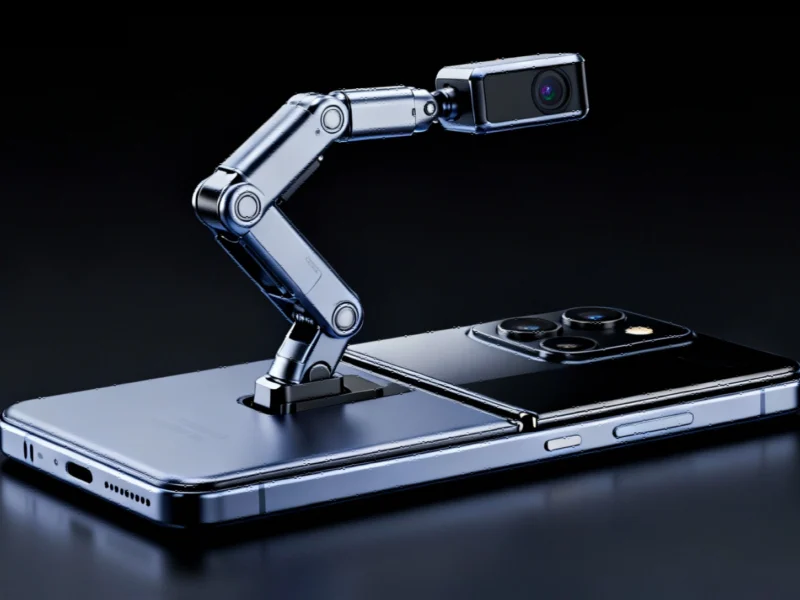In a bold move that redefines mobile computing boundaries, Honor has unveiled a groundbreaking robotic phone prototype that merges artificial intelligence, mechanical engineering, and advanced imaging technologies. This revolutionary device represents the first major milestone in Honor’s Alpha Plan, signaling a strategic shift from conventional smartphones toward what the company describes as “intelligent devices” capable of movement, perception, and contextual understanding.
From Static Device to Dynamic Companion
The prototype showcases a fold-out robotic camera arm that extends fluidly from the device’s body, creating new possibilities for photography, videography, and human-machine interaction. This mechanical innovation, combined with multimodal AI intelligence, enables the device to physically position itself for optimal imaging conditions, essentially functioning as a robotic photography assistant rather than a passive tool. The integration of movement with computational photography represents a significant leap beyond current smartphone capabilities.
Honor’s vision extends far beyond this single device, positioning it as the foundation for an entire ecosystem of AI-driven products. The company’s substantial $10 billion investment commitment over the next five years demonstrates the seriousness of its transformation from smartphone manufacturer to AI device ecosystem leader. This massive funding injection comes as other AI platforms are securing significant investments across different sectors, highlighting the broader industry trend toward AI integration.
The Alpha Plan: A Three-Phase Roadmap to Intelligent Computing
Honor’s strategic blueprint outlines a comprehensive evolution from traditional mobile computing to advanced artificial intelligence integration. The first phase focuses on developing human-centric AI phones that understand and anticipate user needs. The second stage expands this intelligence across an interconnected ecosystem of devices, while the final phase envisions a future where human and artificial intelligence converge in the AGI era.
CEO James Li emphasized that this transformation responds to how AI is fundamentally reshaping productivity, social structures, and cultural norms. “We’re not just building better phones; we’re creating intelligent companions that enhance human capability,” Li stated during the announcement. This approach mirrors developments in expanding AI capabilities across computing platforms, though Honor’s implementation through physical robotics represents a unique direction.
Technical Architecture and Security Considerations
While full specifications remain confidential until MWC Barcelona 2026, the prototype demonstrates sophisticated integration of mechanical systems with AI processing. The robotic arm appears to use precision motors and hinges, controlled by on-device AI that can determine optimal camera positioning based on scene analysis and user behavior patterns.
The security implications of such advanced AI systems cannot be overlooked. As Honor develops these intelligent devices, the company must address potential vulnerabilities similar to those affecting other enterprise systems, such as the critical vulnerabilities recently discovered in Adobe Experience Manager and the particularly dangerous AEM flaws that have emerged in enterprise software. The integration of physical movement with AI decision-making introduces new security dimensions that must be thoroughly addressed.
Industry Partnerships and Ecosystem Development
Honor’s ambitious vision has attracted significant industry support, with Google Cloud, Qualcomm, and Vodafone joining as strategic partners. These collaborations provide crucial infrastructure, connectivity, and processing capabilities necessary for the Robot Phone’s advanced functionality. Qualcomm’s involvement is particularly significant given the company’s parallel initiatives in edge AI and robotics.
The broader industry context shows increasing focus on AI security and reliability. Recent developments include new AI models capable of detecting dangerous chip code with near-perfect accuracy, addressing critical security concerns in hardware manufacturing. Additionally, the record penalties facing companies for data breaches underscore the importance of building security into AI systems from their inception.
Market Implications and Future Trajectory
Honor’s Robot Phone prototype represents more than just a technological showcase—it signals a fundamental shift in how mobile computing devices might evolve. By integrating physical robotics with AI intelligence, Honor is creating a new category of devices that could transform everything from content creation to remote assistance and accessibility.
The company’s expanding product lineup, including AI-powered laptops, tablets, wearables, and audio devices, demonstrates a comprehensive approach to building an interconnected intelligent ecosystem. As the industry moves toward MWC Barcelona 2026, where Honor promises full technical details, the Robot Phone could establish new standards for what constitutes an “intelligent device” and redefine user expectations for mobile computing capabilities.
This development comes at a time when AI integration is becoming increasingly sophisticated across computing platforms, with companies exploring new ways to make artificial intelligence more accessible, useful, and secure. Honor’s robotic approach represents one of the most ambitious implementations of this trend, potentially creating a new benchmark for the industry while raising important questions about privacy, security, and the evolving relationship between humans and intelligent machines.
Based on reporting by {‘uri’: ‘techrepublic.com’, ‘dataType’: ‘news’, ‘title’: ‘TechRepublic’, ‘description’: ‘Providing IT professionals with a unique blend of original content, peer-to-peer advice from the largest community of IT leaders on the Web.’, ‘location’: {‘type’: ‘country’, ‘geoNamesId’: ‘6252001’, ‘label’: {‘eng’: ‘United States’}, ‘population’: 310232863, ‘lat’: 39.76, ‘long’: -98.5, ‘area’: 9629091, ‘continent’: ‘Noth America’}, ‘locationValidated’: False, ‘ranking’: {‘importanceRank’: 199473, ‘alexaGlobalRank’: 3969, ‘alexaCountryRank’: 2546}}. This article aggregates information from publicly available sources. All trademarks and copyrights belong to their respective owners.



